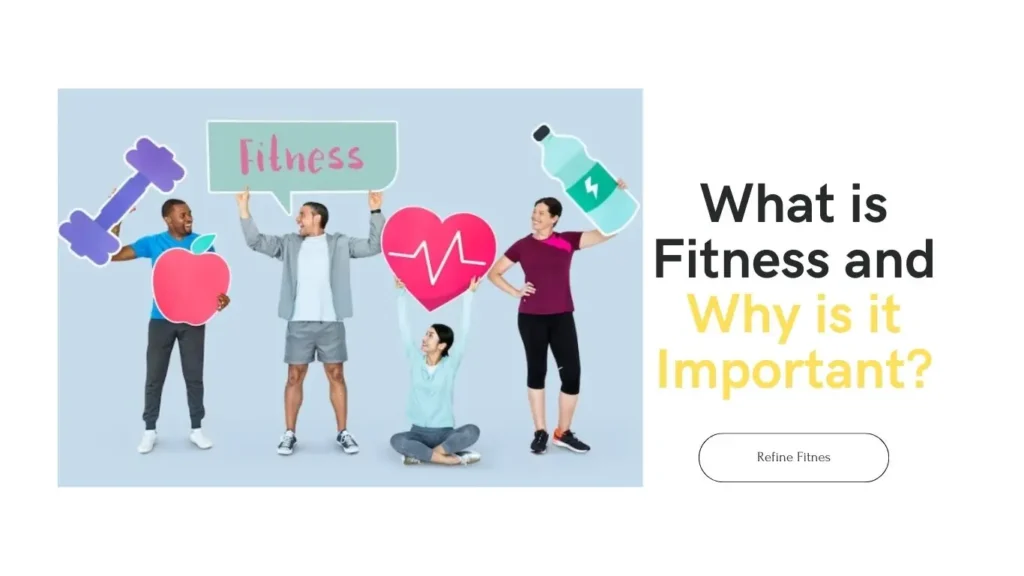Fitness encompasses more than just physical strength; it’s a holistic state of well-being that includes physical, mental, and social aspects. In today’s fast-paced world, understanding the significance of fitness is crucial for leading a healthy and fulfilling life.
Physical Benefits of Fitness
Weight Management
Fitness plays a pivotal role in weight management by helping to regulate metabolism and burn calories efficiently. Regular exercise combined with a balanced diet can aid in achieving and maintaining a healthy weight.
Increased Energy Levels
Engaging in physical activity boosts energy levels by improving circulation and oxygen flow throughout the body. Regular exercise can reduce feelings of fatigue and increase stamina, enhancing overall vitality.
Stronger Immune System
Regular exercise strengthens the immune system, making the body more resilient to infections and illnesses. It helps to flush bacteria out of the lungs and airways, reducing the risk of getting colds and other common ailments.
Improved Cardiovascular Health
Fitness activities such as cardio exercises, running, or swimming are beneficial for heart health. They help to lower blood pressure, improve circulation, and reduce the risk of heart disease, stroke, and other cardiovascular conditions.
Mental Benefits of Fitness

Stress Relief
Exercise is a natural stress reliever, as it prompts the brain to release endorphins, also known as “feel-good” hormones. Physical activity helps to alleviate tension and anxiety, promoting a sense of calm and relaxation.
Enhanced Mood
Regular exercise has been linked to improved mood and mental well-being. It can alleviate symptoms of depression and anxiety by increasing serotonin levels in the brain, leading to a more positive outlook on life.
Better Sleep Quality
Fitness promotes better sleep quality by regulating sleep patterns and promoting relaxation. People who exercise regularly tend to fall asleep faster and enjoy deeper, more restorative sleep.
Increased Cognitive Function
Physical activity stimulates brain function and enhances cognitive abilities such as memory, concentration, and problem-solving skills. It promotes the growth of new brain cells and improves overall brain health.
Social Benefits of Fitness

Opportunities for Social Interaction
Fitness activities provide opportunities for social interaction and networking. Joining group exercise classes or sports teams allows individuals to meet new people and build connections based on shared interests.
Building Relationships
Working out with friends, family, or colleagues fosters a sense of camaraderie and strengthens relationships. Sharing fitness goals and accomplishments can create bonds that extend beyond the gym or workout space.
Encouragement and Support
Engaging in fitness activities within a supportive community can provide encouragement and motivation to stay committed to health and wellness goals. Peer support and accountability can make the fitness journey more enjoyable and sustainable.
Fitness and Longevity
Impact on Lifespan
Maintaining a fit and active lifestyle has been associated with increased longevity and a lower risk of premature death. Regular exercise and healthy habits contribute to overall well-being and longevity.
Reduced Risk of Chronic Diseases
Regular physical activity reduces the risk of developing chronic diseases such as diabetes, heart disease, and certain types of cancer. It helps to control blood sugar levels, lower cholesterol, and maintain healthy blood pressure.
Better Quality of Life in Older Age
Staying fit and active as we age promotes independence and enhances quality of life. It enables older adults to maintain mobility, flexibility, and strength, reducing the risk of falls and injuries.
Fitness and Self-esteem
Improved Body Image
Regular exercise improves body composition and promotes a positive body image. Feeling strong, fit, and healthy boosts self-esteem and self-confidence, regardless of body size or shape.
Boost in Self-confidence
Achieving fitness goals, whether it’s completing a challenging workout or reaching a personal milestone, boosts self-confidence and self-efficacy. It instills a sense of accomplishment and empowerment.
Sense of Achievement
Setting and achieving fitness goals provides a sense of purpose and fulfillment. Overcoming obstacles and pushing past limitations fosters resilience and builds character.
Fitness as a Lifestyle

Incorporating Fitness into Daily Routines
Making fitness a priority involves integrating physical activity into daily routines. Whether it’s taking the stairs instead of the elevator or going for a walk during lunch breaks, finding small ways to stay active adds up over time.
Setting Realistic Goals
Setting achievable fitness goals is essential for long-term success. Whether it’s running a marathon, losing weight, or simply improving overall fitness, setting specific, measurable, and realistic goals keeps individuals motivated and focused.
Finding Enjoyable Activities
Exploring different fitness activities and finding what brings joy and fulfillment is key to maintaining a consistent exercise routine. Whether it’s dancing, hiking, or practicing yoga, finding enjoyable activities makes staying active easier and more sustainable.
Barriers to Fitness
Lack of Time
Busy schedules and competing priorities often make it challenging to find time for exercise. Balancing work, family, and other commitments requires planning and time management.
Financial Constraints
Access to fitness facilities, equipment, and resources may be limited by financial constraints. Gym memberships, personal training sessions, and fitness classes can be costly, making it difficult for some individuals to afford regular exercise.
Motivation Issues
Staying motivated to exercise consistently can be challenging, especially when faced with setbacks or plateaus. Lack of motivation can stem from various factors, including boredom, lack of results, or competing interests.
Accessibility Challenges
Physical disabilities, injuries, or health conditions may present barriers to engaging in certain types of physical activity. Accessibility issues such as lack of wheelchair ramps or adapted equipment can limit participation in fitness activities.
Overcoming Barriers
Prioritizing Fitness
Making fitness a priority requires a mindset shift and a commitment to self-care. Prioritizing physical activity as an essential part of daily life helps individuals overcome obstacles and stay consistent with their fitness routines.
Seeking Affordable Options
When faced with financial constraints, there are still numerous ways to prioritize fitness without breaking the bank.
One option is to explore free or low-cost fitness resources available in the community. Many cities offer free outdoor fitness classes in parks or recreational areas, providing opportunities for individuals to participate in group workouts without the expense of a gym membership. Additionally, community centers often host affordable fitness programs, including yoga, dance, and aerobics classes.
Another cost-effective approach is to take advantage of online resources and mobile apps that offer guided workouts and exercise routines at no cost. From YouTube channels dedicated to fitness tutorials to mobile apps offering personalized training plans, there’s a wealth of digital resources available to support individuals in their fitness journey without requiring a financial investment.
Exploring Community Resources
For those interested in gym memberships but deterred by the cost, exploring alternative options such as community or nonprofit fitness centers can be beneficial. These facilities often offer discounted rates or sliding-scale fees based on income, making fitness more accessible to individuals from diverse socioeconomic backgrounds.
Moreover, many employers offer wellness programs or incentives for employees to engage in physical activity, such as subsidized gym memberships or onsite fitness classes. Taking advantage of these workplace benefits can not only save money but also promote a culture of health and well-being within the organization.
Ultimately, prioritizing fitness doesn’t have to mean spending a significant amount of money. By seeking out affordable options and making use of available resources, individuals can overcome financial barriers and embrace a healthy, active lifestyle.
Conclusion
Fitness is not just about physical strength; it encompasses mental, social, and emotional well-being as well. Understanding the importance of fitness is essential for leading a healthy and fulfilling life. From the physical benefits of weight management and improved cardiovascular health to the mental benefits of stress relief and enhanced mood, prioritizing fitness offers a multitude of advantages. Additionally, the social benefits of connecting with others through fitness activities contribute to a sense of belonging and support. Despite potential barriers such as lack of time, financial constraints, or motivation issues, there are strategies for overcoming these obstacles and making fitness a sustainable part of daily life. By prioritizing fitness and embracing a holistic approach to well-being, individuals can enhance their quality of life and enjoy the many rewards that come with being active and healthy.
FAQs
Why is fitness important?
Fitness is important because it contributes to overall health and well-being, encompassing physical, mental, and social aspects. Engaging in regular physical activity can improve cardiovascular health, manage weight, reduce stress, and enhance mood.
How can I incorporate fitness into my daily routine?
You can incorporate fitness into your daily routine by finding activities you enjoy, setting realistic goals, and making time for exercise. Whether it’s taking a walk during your lunch break or joining a group fitness class after work, finding ways to stay active throughout the day is key.
What are some affordable options for staying fit?
Affordable options for staying fit include taking advantage of free outdoor fitness classes, exploring online resources and mobile apps, and seeking out community or nonprofit fitness centers that offer discounted rates. Additionally, some employers offer wellness programs or incentives for employees to engage in physical activity.
How can I stay motivated to exercise regularly?
To stay motivated to exercise regularly, set specific and achievable goals, vary your workouts to prevent boredom, find a workout buddy or support group, and track your progress over time. Celebrating small victories and focusing on the benefits of exercise can also help maintain motivation.
What are the long-term benefits of prioritizing fitness?
Prioritizing fitness offers numerous long-term benefits, including increased longevity, reduced risk of chronic diseases, improved quality of life in older age, and enhanced self-esteem and confidence. By making fitness a priority, individuals can enjoy a healthier and more fulfilling life.

